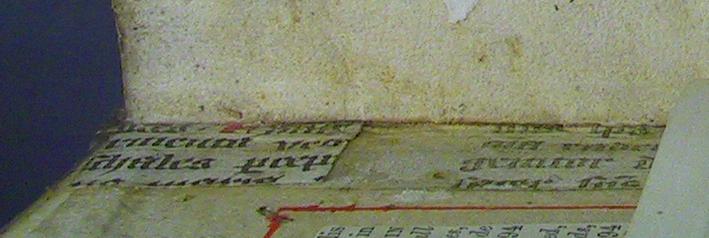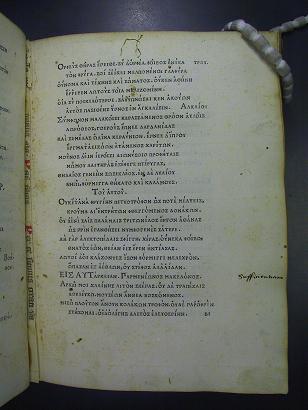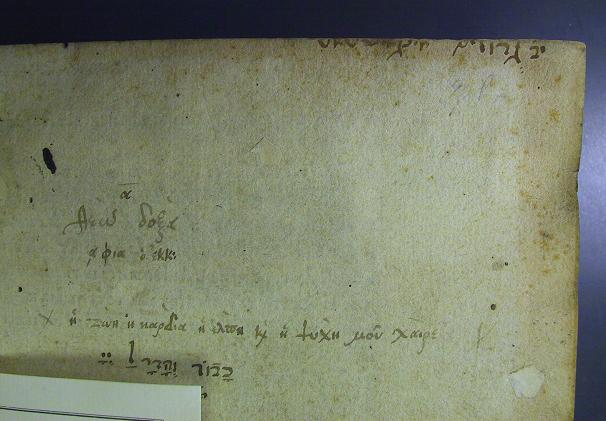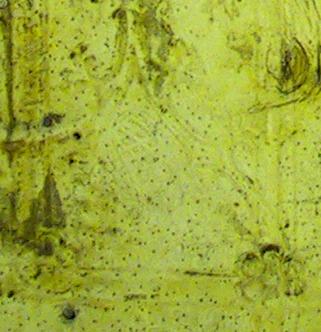The Cambridge University Library copy of the Anthologia Graeca Planudea pubblished by Janus Lascaris and printed by Laurentius (Francisci) de Alopa Venetus in Florence on 11 August 1494 (
ISTC ia00765000) comes from the Sandars Collection, which is particularly rich in original and de-luxe bindings (
SSS.60.10) . This book retains its original binding too.

upper cover

lower cover
The cover is made a of quarter blind-tooled pigskin over bevelled wooden boards, with two stubs of fastening pigskin straps at fore-edge of lower board and channeling and nail holes for two lost catches at fore-edge of the upper board. It is clearly German and datable to the end of the 15th or the beginning of the 16th century.

Upper guard
The parchment guards of the first and last gatherings A and KK are fragments from a 15th-century liturgical German manuscript in Gothic hand with rubrics and initials in red.

B1 recto
The margins bear some marginal manuscript notabilia both in Latin and Greek in cursive hand by a German reader of the early 16th century.
More intriguingly, the book is also inscribed with notes by different hands in Greek and Hebrew on the blank recto of its title page, i.e. leaf [A1] recto: a classical citation [?], an imploration to God, and a partly cropped note written by a less educated hand in the upper margin of the leaf.

A1 recto
This short note turned out to be the most interesting one. Written in Yiddish in an Hebrew hand datable to the end of the 15th century, it reads “12 grozim Ingolstadt”, providing us with a price and the name of the German town in which the book was at the end of the 15th or the beginning of the 16th century (I am most grateful to my colleagues from the Geniza Project, and Dr Esther-Miriam Wagner in particular, who kindly helped me in reading and dating the Hebrew inscriptions).

Yiddish inscription
The cropping indicates that the note was written before the book was bound. A quick provenance search for incunables from Ingolstadt in the BSB-Ink website (BSB-Ink, H-372) led to the discovery of another incunable bound in similar style and decorated with seemingly identical tools. The book is a copy of Horatius’s Opera printed in Venice [by Philippus Pincius partly with Bevilaqua’s types] and dated 13 July 1498 (ISTC ih00459000), now in the Bayerische StaatsBibliothek in Munich, 2 Inc.ca 3652 m, which was bound in Ingolstadt in the workshop of Johannes Ewring (for similar bindins in Ingolstadt, see E. Kyriss, Verzierte gotische Einbände im alten deutschen Sprachgebiet, 4 vols, Stuttgart, 1951-1958, no. 170).
The BSB-Ink record provides a link to a German Bindings Database, called Einbanddatenbank, with images and measures of all the tools used in Johannes Ewring’s workshop (EBDB w000030), six of which can also be found on the binding of the Greek anthology in Cambridge (Ewring’s tools).




K2 recto
According to the Einbanddatenbank, Johannes Ewring was active in Ingolstadt between 1475 and 1514. One of the notabilia added by the German reader in Latin and Greek on the book margins of our anthology is dated “1513 die 2°” (leaf K2 recto), thus providing us with a certain “terminus ante quem” for the binding.
The book was therefore bound in Ingolstadt in the workshop of Johannes Ewring sometime between 1494, its printing date, and 1513, the date of the annotation.
Miriam also came up with an interesting idea: could the Yiddish inscription be a pawnshop remark? Books were often used as pawn items within the Jewish community, and the Jewish lenders should therefore have been used to take books as pawn items from Christian customers. If this was the case, the book must have been used as “collateral” in a lending transaction before the bookblock was cropped in preparation for its binding when part of the note in Yiddish was cut away.
It only befits the international nature of this book that international experts in Hebrew and Yiddish languages from the Geniza Project at Cambridge University Library, and international digital catalogues with images available on-line have made possible for me, and Italian incunabula cataloguer, to solve a little but intriguing busillis.
![Inc.0.A.7.2[888], fol. XCV verso - reduced](https://inc-blog.lib.cam.ac.uk/wp-content/uploads/2012/12/Inc.0.A.7.2888-fol.-XCV-verso-reduced5-e1355403462857-244x300.jpg)









